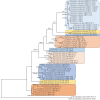Phylogeny and taxonomy of three new Ctenomyces (Arthrodermataceae, Onygenales) species from China
- PMID: 30820164
- PMCID: PMC6393398
- DOI: 10.3897/mycokeys.47.30740
Phylogeny and taxonomy of three new Ctenomyces (Arthrodermataceae, Onygenales) species from China
Abstract
Twelve Ctenomyces (Arthrodermataceae, Onygenales) strains were obtained and identified during a survey of keratinophilic fungi in soils from China. We used molecular identification combined with morphological evidence to delimit species, circumscribing five species in the genus. Three new species are herein described: C.albus sp. nov., C.obovatus sp. nov. and C.peltricolor sp. nov. We also described, illustrated and compared the novel species with related species in the morphology.
Keywords: Ctenomyces; 3 new species; Filamentous fungi; Morphology; Multigene.
Figures






Similar articles
-
Diversity of Onygenalean Fungi in Keratin-Rich Habitats of Maharashtra (India) and Description of Three Novel Taxa.Mycopathologia. 2020 Feb;185(1):67-85. doi: 10.1007/s11046-019-00346-7. Epub 2019 Jun 11. Mycopathologia. 2020. PMID: 31187339
-
Keratinophyton chongqingense sp. nov. and Keratinophyton sichuanense sp. nov., from soil in China.Int J Syst Evol Microbiol. 2022 Aug;72(8). doi: 10.1099/ijsem.0.005468. Int J Syst Evol Microbiol. 2022. PMID: 35930466
-
Keratinophilic fungi from the vicinity of salt pan soils of Sambhar lake Rajasthan (India).J Mycol Med. 2018 Sep;28(3):457-461. doi: 10.1016/j.mycmed.2018.06.002. Epub 2018 Jun 30. J Mycol Med. 2018. PMID: 29970292
-
Molecular phylogeny and taxonomy of medically important fungi.Med Mycol. 1998;36 Suppl 1:52-6. Med Mycol. 1998. PMID: 9988492 Review.
-
Taxonomic revision of the genus Neopleurophora Brown (Diptera: Phoridae), with the description of thirty seven new species.Zootaxa. 2013;3657:1-93. doi: 10.11646/zootaxa.3657.1.1. Zootaxa. 2013. PMID: 25333088 Review.
Cited by
-
Insights into Some Onygenalean Fungi from Freshwater Sediments in Spain and Description of Novel Taxa.J Fungi (Basel). 2023 Nov 22;9(12):1129. doi: 10.3390/jof9121129. J Fungi (Basel). 2023. PMID: 38132730 Free PMC article.
-
Culturable Fungi from Urban Soils in China I: Description of 10 New Taxa.Microbiol Spectr. 2021 Oct 31;9(2):e0086721. doi: 10.1128/Spectrum.00867-21. Epub 2021 Oct 6. Microbiol Spectr. 2021. PMID: 34612666 Free PMC article.
-
Culturable fungi from urban soils in China II, with the description of 18 novel species in Ascomycota (Dothideomycetes, Eurotiomycetes, Leotiomycetes and Sordariomycetes).MycoKeys. 2023 Jun 29;98:167-220. doi: 10.3897/mycokeys.98.102816. eCollection 2023. MycoKeys. 2023. PMID: 37425100 Free PMC article.
-
Genomic Sequencing and Functional Analysis of the Ex-Type Strain of Malbranchea zuffiana.J Fungi (Basel). 2024 Aug 24;10(9):600. doi: 10.3390/jof10090600. J Fungi (Basel). 2024. PMID: 39330360 Free PMC article.
-
Phylogeny and taxonomy of two new Plectosphaerella (Plectosphaerellaceae, Glomerellales) species from China.MycoKeys. 2019 Aug 7;57:47-60. doi: 10.3897/mycokeys.57.36628. eCollection 2019. MycoKeys. 2019. PMID: 31423085 Free PMC article.
References
-
- de Hoog GS, Guarro J, Gené J, Figueras MJ. (2000) Atlas of Clinical Fungi (2nd edn). American Society for Microbiology Press, Washington, DC.
LinkOut - more resources
Full Text Sources
